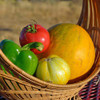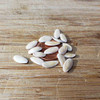Collective Farm Woman Melon - (Cucumis melo var. inodorus)
- SKU:
- V1380
- Seed Count:
- Approx 25 seeds per pack
- Days to Maturity:
- 80-85 days
- Type:
- Muskmelon
- Days to Germination:
- 3-5 days @ 80-90F
- Plant Spacing:
- 12-18"
- Light Preference:
- Full sun
- Soil Requirements:
- Warm soil
- Status:
- Heirloom, Non-Hybrid, Non-GMO seeds
Description
Collective Farm Woman Melon - Short Season Sweetness
A delicious, treasured Russian cultivar bred specifically for cooler, shorter season gardens by Russian plant breeder V. Balyasnyi in the early 1930s. It became extremely popular with Moscow dacha gardeners when introduced and is still the most popular melon variety in former Soviet Union countries, especially Ukraine because it ripens early enough to provide fruit before the frosts arrive.
Details
Melons ripen to a yellowish-gold with a very sweet and richly flavored crisp white flesh that is firm but melts in your mouth, a favorite among heirloom gardeners and growers alike. Flavor and aroma are described as “particularly rich, floral and sweet” or “melted in my mouth” with flavor going all the way to the rind, while others describe it as “a bit like a pear crossed with a honey dew with a little musky spice added to it.” Ripens early as expected from a cool weather melon.
Sets fruit regularly throughout the growing season, starting with a small dark green speckled golf ball size and ripening to the size of a large grapefruit.
It is very easy to tell when ripe as it turns a golden yellow and slips from the stem. Best flavor develops when yellow-orange rind appears and vine loosens from melon, so early picking loses flavor.
This short-season melon can be planted twice for double harvests in temperate, longer-season climates.
History
This melon was bred by traditional methods in the 1930s at the Biryuchekutsk Vegetable Breeding Station Novocherkassk, in the Rostov region of Southern Russia near the Black Sea, becoming very popular soon after its introduction.
Collective Farm Woman Melon is the English translation of the original name and breeding strain - Kolkhoznitsa 749/753. There are several other Kolkhoznitsa varieties with different breeding numbers, but this one is the best known and most widely grown in home gardens across Russia, Ukraine, and the US.
In the early 1990s, any Moscow gardener could buy seeds for this melon in any seed shop or farmers market around Moscow.
When Marina Danilenko of Moscow brought the seed to Seed Savers Exchange in 1993, she bestowed a huge favor on all home gardeners in the US and beyond by gifting us the heritage and flavor of this exceptional, unique short-season melon.
Uses
Collective Farm Woman melons are best eaten fresh from the vine, still warm from the garden once they slip their vines and are fully ripened.
Use your imagination to discover unique ways of incorporating the incomparable flavor these melons give - sliver into salads, top vanilla ice cream, use with prosciutto as appetizers, the uses are many!
Growing Tip
Melons prefer a warm soil temperature and their plants are often stunted and don’t recover much when planted in cool soil, so it is best to wait until the soil is warm to the touch first thing in the morning to plant the seeds.
It is highly recommended to wait to direct sow a couple of weeks or so after the last frost. You won’t lose growth, and early planting in cool soil can set you back all season long.
They can also be started in pots a couple of weeks before time to set out to get a little bit of a head start, just make sure to use a pot that is at least 3-4" in diameter to avoid disturbing the roots as much as possible when transplanting.
Learn More
From the soil to the seed to the food you eat - we'll help you grow your best garden!



















